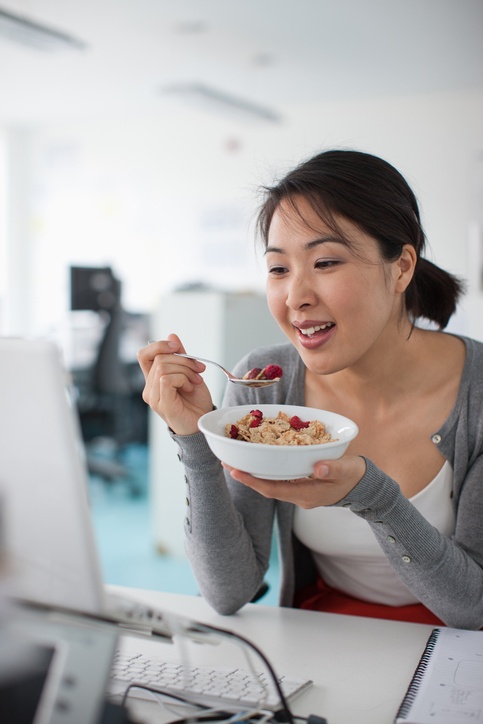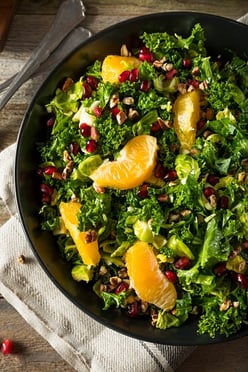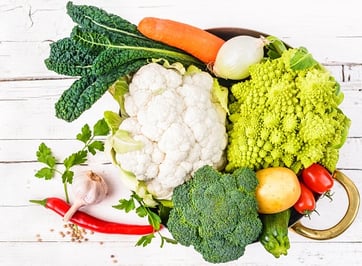We all know that a lot of holidays involve food: cookouts on the 4th of July, cookies for Santa at Christmas, and candy treats for Halloween. But one holiday completely revolves around food—when you think of it, you automatically think about food. Thanksgiving is all about the meal of turkey, sides, and desserts. Several food myths surround this holiday, however, and not all of them are true. Keep reading for myth busters to share at your table.

- Turkey makes you sleepy. Always have a nap after your Thanksgiving meal? Have you been blaming the turkey because you heard it was high in tryptophan, an amino acid that is converted to serotonin and then melatonin and causes you to sleep? The truth is that a lot of other foods on the dinner table have much higher levels of tryptophan, and the real reason for the nap is more likely because of the amount of carbs that you consumed (and possibly the number of glasses of wine you drank!).
- Sweet potatoes are always better than white potatoes. It’s true that if you look at the nutritional components of a regular sweet potato compared to those of a white potato, hands down it wins for its higher levels of vitamin A and C and fiber. The typical sweet potato dish is loaded with sugar and fat, however, and not nearly as healthy as a plain baked white potato.
- Dark meat is unhealthy. Yes, it is true that white meat is very lean and an excellent source of protein. Dark meat is not so terrible, though, that you should intentionally avoid putting it on your Thanksgiving plate. A serving of 4 oz of white meat is 158 calories vs. 183 for dark meat, and 0.5 gram of saturated fat vs. 1.6 grams of saturated fat. Dark meat is also higher in zinc and iron.
- Canned pumpkin isn’t as healthy as fresh. I am sure you have heard multiple times how much healthier fresh fruits and vegetables are versus canned. This is typically due to processing them and then storing them in a high-sodium or high-sugar liquid. However, when it comes to canned pumpkin, that rule doesn’t apply. It’s more concentrated than a fresh pumpkin, which means more vitamin A and fiber. But be careful when grabbing a can of pumpkin and don’t accidentally grab pumpkin pie filling, which is loaded with sugar and salt.
- Stuffing and dressing are the same thing. They are very similar, but not the same. Stuffing is typically stuffed inside the bird, whereas dressing is prepared in a casserole dish. A note about food safety: Be cautious when eating traditional stuffing that is cooked inside the bird. It adds mass to the turkey, which slows the cooking. This not only dries out the meat, but can create salmonella bacteria. Always be sure your turkey is cooked to 165 degrees.
Show up at the Thanksgiving holiday this year with these healthy eating myth busters to share with your family and friends (and also check out these additional Thanksgiving hacks). Then grab a plate, load it up with lots white and dark meat, and enjoy the once-a-year food fest!
This blog was written by Angie Mitchell, RD, Wellness Coordinator. To find out more about the NIFS bloggers, click here.


 We’ve all heard the phrase that an apple a day keeps the doctor away, but who knew that eating a balanced diet would also make you more productive at work? That’s what was found in a
We’ve all heard the phrase that an apple a day keeps the doctor away, but who knew that eating a balanced diet would also make you more productive at work? That’s what was found in a  This is definitely my favorite time of year: football, cooler weather, and the return of all things apple and pumpkin. Not only are they chock-full of vitamins and other healthy goodness, but they are also delicious!
This is definitely my favorite time of year: football, cooler weather, and the return of all things apple and pumpkin. Not only are they chock-full of vitamins and other healthy goodness, but they are also delicious! Coconut oil definitely seemed like the food craze a few years ago. A popular choice in
Coconut oil definitely seemed like the food craze a few years ago. A popular choice in  Fluid (mainly
Fluid (mainly  One of my favorite things to do during summer in Indiana is to visit the various farmers’ markets around the Indianapolis area. As a dietitian I am a sucker for the fresh fruits and veggies, but I also love the homemade desserts, candles, pasta, kettle corn, fresh flowers, and other wonderful items you can find.
One of my favorite things to do during summer in Indiana is to visit the various farmers’ markets around the Indianapolis area. As a dietitian I am a sucker for the fresh fruits and veggies, but I also love the homemade desserts, candles, pasta, kettle corn, fresh flowers, and other wonderful items you can find. The weather is warming up, the flowers are coming out, and daylight is around much longer at night. All of these things mean one thing: time to start grilling again! Having a barbecue or cookout is a wonderful way to do a majority of your cooking because it is a healthy preparation method and leaves little to no cleanup in the kitchen!
The weather is warming up, the flowers are coming out, and daylight is around much longer at night. All of these things mean one thing: time to start grilling again! Having a barbecue or cookout is a wonderful way to do a majority of your cooking because it is a healthy preparation method and leaves little to no cleanup in the kitchen! You lose 15 pounds. Then gain back 10. Then it’s time to try the newest diet out there and you lose 20 pounds. Then gain 20 back. Does this cycle sound familiar? This is called yo-yo dieting, or the cycle of gaining and losing the same pounds over and over again. This cycle is dangerous because of its long-term health effects. Hopefully reading through these dangers will prevent you from trying the next fad diet craze and instead adopt the theory of “slow and steady!”
You lose 15 pounds. Then gain back 10. Then it’s time to try the newest diet out there and you lose 20 pounds. Then gain 20 back. Does this cycle sound familiar? This is called yo-yo dieting, or the cycle of gaining and losing the same pounds over and over again. This cycle is dangerous because of its long-term health effects. Hopefully reading through these dangers will prevent you from trying the next fad diet craze and instead adopt the theory of “slow and steady!” You’ve seen it on the news and read articles in magazines, but is it really true? Can chocolate actually be good for you? Isn’t it too delicious and forbidden to be a food that can help with heart disease? Of course nutrition is confusing and things change all the time about what is good and isn’t so good for you, so what is the deal with chocolate?
You’ve seen it on the news and read articles in magazines, but is it really true? Can chocolate actually be good for you? Isn’t it too delicious and forbidden to be a food that can help with heart disease? Of course nutrition is confusing and things change all the time about what is good and isn’t so good for you, so what is the deal with chocolate?  Cocoa naturally has a very strong taste, so it has to go through many steps to form your favorite type of chocolate. And through this processing many of the flavanols are lost. Most commercial chocolates are highly processed, and therefore have the lowest amount of antioxidants. However, dark chocolate that has undergone minimal processing will have the highest amount of flavonoids. As far as cocoa goes, the best choice is one that hasn’t undergone Dutch processing, which is when they treat it with an alkali to neutralize the natural acidity. (For more about how chocolate is created and how to enjoy it, check out
Cocoa naturally has a very strong taste, so it has to go through many steps to form your favorite type of chocolate. And through this processing many of the flavanols are lost. Most commercial chocolates are highly processed, and therefore have the lowest amount of antioxidants. However, dark chocolate that has undergone minimal processing will have the highest amount of flavonoids. As far as cocoa goes, the best choice is one that hasn’t undergone Dutch processing, which is when they treat it with an alkali to neutralize the natural acidity. (For more about how chocolate is created and how to enjoy it, check out  Are you uninspired on the vegetable front once the weather turns cold and the local fresh produce is no longer available? Luckily there are some hearty winter vegetables that I challenge you to try: Brussels sprouts, cauliflower, and kale. These whole foods will add some variety to your current lineup—and help you get the nutrition you need more easily. Below are recipes to try.
Are you uninspired on the vegetable front once the weather turns cold and the local fresh produce is no longer available? Luckily there are some hearty winter vegetables that I challenge you to try: Brussels sprouts, cauliflower, and kale. These whole foods will add some variety to your current lineup—and help you get the nutrition you need more easily. Below are recipes to try.